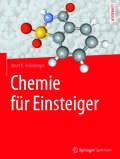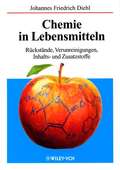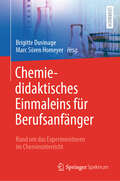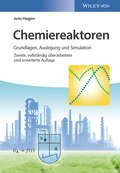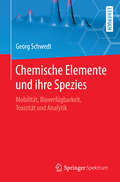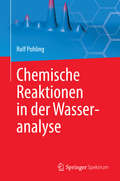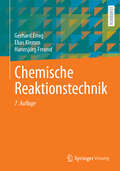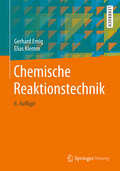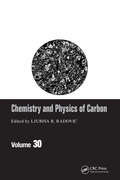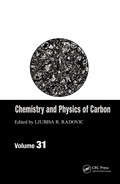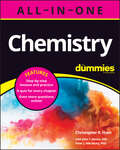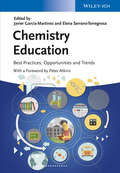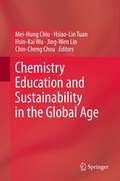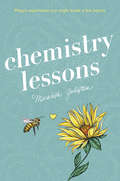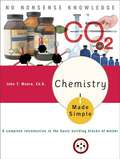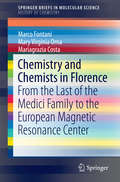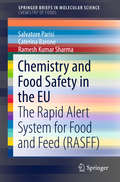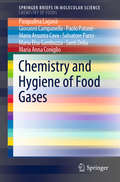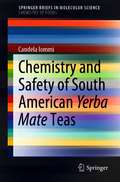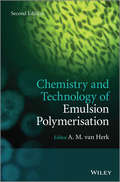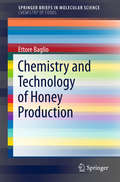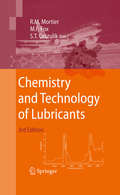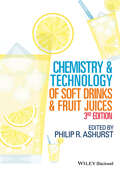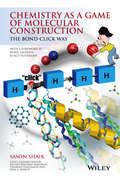- Table View
- List View
Chemie für Einsteiger
by Josef K. FelixbergerDas Buch ist eine leicht verständliche Einführung in die Welt der Chemie mit hohem praktischem Nutzen, angereichert mit zahlreichen anschaulichen Beispielen aus Alltag, Industrie, Wirtschaft, Politik und Geschichte. Eine reich bebilderte Darstellung der Allgemeinen und Anorganischen Chemie, der Organischen Chemie und Biochemie und last, but not least der Polymerchemie und Kunststoffverarbeitung. Gleichermaßen empfehlenswert für Studienanfänger mit Nebenfach Chemie, für Kaufleute und Techniker, Schüler und Lehrer sowie für interessierte Laien.
Chemie in Lebensmitteln: Rückstände, Verunreinigungen, Inhalts- und Zusatzstoffe (Universitätstaschenbücher Ser. #675)
by Johannes Friedrich DiehlFast taglich berichten die Medien Ãber Lebensmittelskandale und "chemisch verseuchte" Nahrung. Ob Rackstände von Pflanzenschutzmitteln in Obst und Gemase, von Tierarzneimitteln in Fleisch, Milch und Eiern, ob Schwermetalle oder Dioxine - mit modernen Analysenverfahren kannen die geringsten Spuren solcher Stoffe sehr zuverlassig nachgewiesen werden. Aber welche gesundheitliche Risiken sind mit dem Vorhandensein dieser Substanzen in der Nahrung verbunden? Die Lebensmittelbranche versichert uns, ihre Produkte seien nicht nur unbedenklich zu genieà en, sondern gesundheitlich sicherer als je zuvor. Kritiker des heutigen Lebensmittelangebots warnen dagegen vor schlimmen Folgen. Was stimmt nun, welche Argumente kannen Ãberzeugen? Ein solch komplexes und heikles Thema wie "Chemie in Lebensmitteln" verlangt nach Beurteilung und Erlauterung durch unabhangige Experten. Als solcher hat sich Johannes Friedrich Diehl, viele Jahre Leiter der Bundesforschungsanstalt far Ernährung, durch zahlreiche Veraffentlichungen und Gutachten sowie durch seine Mitarbeit in Beratergremien einen Namen gemacht. Ohne zu beschanigen und ohne zu dramatisieren berichtet er Ãber die neuesten Erkenntnisse zur gesundheitlichen Qualitat von Lebensmitteln, Ãber aktuelle Entwicklungen bei der Zulassung und Verwendung von Zusatzstoffen, Ãber den erstaunlichen Wandel in den Ansichten Ãber Zusammenhänge zwischen Ernährung und Krebs, Allergien und anderen Krankheiten sowie Ãber die gesundheitsschädlichen und -fardernden Wirkungen natürlicher Lebensmittelinhaltsstoffe. Das mit fundiertem wissenschaftlichem Hintergrund, jedoch far einen breiten Leserkreis geschriebene Buch kann zugleich als fesselnde Lektare und als Nachschlagewerk Ernahrungsberatern, à rzten, Apothekern, Ökotrophologen, Agronomen und Chemikern dienen - natarlich auch allen, die sich eine eigene Meinung bilden wollen.
Chemiedidaktisches Einmaleins für Berufsanfänger: Rund um das Experimentieren im Chemieunterricht
by Brigitte Duvinage Marc Sören HomeyerDieses Lehrbuch richtet sich insbesondere an Quereinsteiger für das Fach Chemie, um Ihnen für den Berufseinstieg wesentliche fachdidaktische Grundlagenkenntnisse, die in steter Wechselbeziehung mit dem Einsatz von Experimenten und dem Aufbau von Wissensstrukturen stehen, aufzuzeigen. Die damit verbundenen Kompetenzentwicklungen werden praxisrelevant in den Kapiteln diskutiert, und sie sind mühelos autodidaktisch zu erschließen. In ausgewählten Unterrichtsbausteinen werden theoretisch diskutierte Aspekte mit Blick auf den Beitrag des Experimentes und der Entwicklung rahmenplanadäquater Kompetenzen konkretisiert. Unterschiedliche Materialien für die Planung und den Unterricht sind darin eingebunden. Didaktisch-methodische Hinweise runden die Kapitel ab. Im Kapitel 14 steht das sichere und souveräne Experimentieren mit und für Lernende im Mittelpunkt. Aufgaben und Lösungen in einzelnen Kapiteln dienen der Überprüfung der eigenen Kompetenzen für die Planungsarbeit. Letztlich werden auch Referendare und Lehrende für Naturwissenschaften in diesem Buch einen nicht zu unterschätzenden Wissensfundus entdecken.
Chemiereaktoren: Grundlagen, Auslegung und Simulation
by Jens HagenKenntnisse der Auslegung und Simulation von Chemiereaktoren sind die Voraussetzung für den optimalen technischen und wirtschaftlichen Betrieb von chemischen Prozessen. In der neuen Auflage von "Chemiereaktoren" gibt Jens Hagen einen bewährten und verständlichen Einstieg in das komplexe Thema und vermittelt die Grundlagen der Reaktionstechnik. Alle erforderlichen Auslegungsgleichungen auf Basis der Stoff-, Wärme- und Impulsbilanz unter Berücksichtigung von Stöchiometrie und Kinetik der Reaktionen werden abgeleitet und erläutert. Jedes Kapitel enthält vollständig durchgerechnete Beispiele und Übungsaufgaben mit kommentierten Lösungen. Um einen Einstieg in die Modellierung und Simulation von Chemiereaktoren zu geben, nutzt Jens Hagen das Softwarepaket POLYMATH, das das Finden von numerischen Problemlösungen leicht nachvollziehbar und mit geringem Aufwand erlaubt. Zielgerichtet wird die Modellierung von Problemstellungen geübt und es werden verständliche Lösungswege aufgezeigt, um Probleme aus der Praxis zu lösen. In der zweiten Auflage wurde das Buch um die Lösung von Differenzialgleichungen zweiter Ordnung und von partiellen Differenzialgleichungen erweitert, um komplexere Fragestellungen des Stoff- und Wärmeaustauschs lösen zu können. Zusätzlich wurden viele neue Beispiele und Simulationen aufgenommen, die reale Probleme in der Reaktionstechnik widerspiegeln und eine Übertragung der Beispiele in die Praxis erleichtern.
Chemische Elemente und ihre Spezies: Mobilität, Bioverfügbarkeit, Toxizität und Analytik
by Georg SchwedtDas Buch stellt Methoden und Strategien zur differenzierten Analytik und Bewertung von chemischen Elementen in Wasser, Boden und Lebensmitteln vor zum Zwecke der Bewertung von Mobilit#65533;t, Toxizit#65533;t und Bioverf#65533;gbarkeit. Denn es ist eben nicht nur die Dosis, die ein Gift zum Gift macht, sondern auch die Art der Spezies.
Chemische Reaktionen in der Wasseranalyse
by Rolf PohlingDieses Buch ist dem Praktiker eine Hilfe in der Wasseranalyse. Es erläutert die chemischen Reaktionen und Zusammenhänge, z. B. warum sich eine Lösung durch Zugabe eines spezifischen Reagenzes färbt, es werden aber auch die Reaktionen zur Beseitigung von Störungen aufgezeigt. Es können in der Analyse auch mehrere Störungen auftreten. Damit verfügt der Wasseranalytiker über eine Ergänzung zu seinem analytischem Vorschriftenbuch. Insgesamt kann dabei ein beträchtliches theoretisches Rüstzeug erarbeitet werden, das nicht nur für die Wasseranalyse von Bedeutung ist. Es sind 40 Parameter in alphabetischer Reihenfolge aufgezeigt, in denen bis zu 10 Methoden des Parameters als chemische Reaktionen und mit ihren organischen Strukturen aufgeführt sind. Zusätzlich sind Vorkommen, Herkunft und Bedeutung der Verschmutzungsparameter beschrieben. Das Buch trägt damit erheblich zum Verständnis der Wasseranalyse bei und darf in keinem Labor fehlen, in dem Wasseranalysen durchgeführt werden.
Chemische Reaktionstechnik
by Gerhard Emig Elias Klemm Hannsjörg FreundDieses Werk ist ein bewährter Lehrbuch-Klassiker im Bereich der Technischen Chemie. Als vollständige Einführung in das Fachgebiet der Chemischen Reaktionstechnik unterstützt es in idealer Weise sowohl das akademische Studium als auch die Arbeit in der industriellen Praxis. Es ist für die Fachrichtungen Chemieingenieurwesen, Chemie und Verfahrenstechnik gleichermaßen geeignet und wird seit vielen Jahren im Lehrprofil Technische Chemie der DECHEMA empfohlen.Mit dieser Neuauflage erfolgte eine leichte Überarbeitung und die Ergänzung eines neuen Kapitels zur elektrochemischen Reaktionstechnik. Gliederung und Struktur des Lehrbuchs haben sich bewährt und wurden beibehalten.
Chemische Reaktionstechnik: Einfuhrung In Die Chemische Reaktionstechnik (Springer-Lehrbuch)
by Gerhard Emig Elias KlemmDie neue vollständig überarbeitete Auflage dieses schon klassischen Lehrbuches berücksichtigt vor allem den Einsatz moderner Methoden in der chemischen Reaktionstechnik sowie die Entwicklungstendenzen im Bereich Modellierung und damit in der Computeranwendung. Dies ist auch der Grund, weshalb ein weiterer Autor aus dem aktiven Hochschuldienst das Autorenteam ergänzt. Im einzelnen wurden folgende Teile neu aufgenommen: - Fluid-Fluid-Reaktionen - Stöchiometrie chemischer Reaktionen - Wirbelschichtreaktoren - Stark erweiterter mathematischer Anhang, zugeschnitten auf den Computereinsatz - Symbolverzeichnis
Chemistry & Physics of Carbon: Volume 30 (Chemistry and Physics of Carbon)
by Ljubisa R. RadovicWritten by distinguished researchers in carbon, the long-running Chemistry and Physics of Carbon series provides a comprehensive and critical overview of carbon in terms of molecular structure, intermolecular relationships, bulk and surface properties, and their behavior in an amazing variety of current and emerging applications, rang
Chemistry & Physics of Carbon: Volume 31 (Chemistry and Physics of Carbon)
by Ljubisa R. RadovicWritten by distinguished researchers, the long-running Chemistry and Physics of Carbon series provides a comprehensive and critical overview of carbon materials in terms of molecular structure, intermolecular relationships, bulk and surface properties, and their behavior in current and emerging applications. Volume 31 not only retains the high-qual
Chemistry All-in-One For Dummies (+ Chapter Quizzes Online)
by John T. Moore Peter J. Mikulecky Christopher R. HrenEverything you need to crush chemistry with confidence Chemistry All-in-One For Dummies arms you with all the no-nonsense, how-to content you&’ll need to pass your chemistry class with flying colors. You&’ll find tons of practical examples and practice problems, and you&’ll get access to an online quiz for every chapter. Reinforce the concepts you learn in the classroom and beef up your understanding of all the chemistry topics covered in the standard curriculum. Prepping for the AP Chemistry exam? Dummies has your back, with plenty of review before test day. With clear definitions, concise explanations, and plenty of helpful information on everything from matter and molecules to moles and measurements, Chemistry All-in-One For Dummies is a one-stop resource for chem students of all valences. Review all the topics covered in a full-year high school chemistry course or one semester of college chemistry Understand atoms, molecules, and the periodic table of elements Master chemical equations, solutions, and states of matter Complete practice problems and end-of-chapter quizzes (online!)Chemistry All-In-One For Dummies is perfect for students who need help with coursework or want to cram extra hard to ace that chem test.
Chemistry Education
by Elena Serrano-Torregrosa Javier Garc?a-Mart?nez Peter W. AtkinsThis comprehensive collection of top-level contributions provides a thorough review of the vibrant field of chemistry education. Highly-experienced chemistry professors and education experts cover the latest developments in chemistry learning and teaching, as well as the pivotal role of chemistry for shaping a more sustainable future. Adopting a practice-oriented approach, the current challenges and opportunities posed by chemistry education are critically discussed, highlighting the pitfalls that can occur in teaching chemistry and how to circumvent them. The main topics discussed include best practices, project-based education, blended learning and the role of technology, including e-learning, and science visualization. Hands-on recommendations on how to optimally implement innovative strategies of teaching chemistry at university and high-school levels make this book an essential resource for anybody interested in either teaching or learning chemistry more effectively, from experience chemistry professors to secondary school teachers, from educators with no formal training in didactics to frustrated chemistry students.
Chemistry Education and Sustainability in the Global Age
by Mei-Hung Chiu Jing-Wen Lin Hsin-Kai Wu Hsiao-Lin Tuan Chin-Cheng ChouThis edited volume of papers from the twenty first International Conference on Chemical Education attests to our rapidly changing understanding of the chemistry itself as well as to the potentially enormous material changes in how it might be taught in the future. Covering the full range of appropriate topics, the book features work exploring themes as various as e-learning and innovations in instruction, and micro-scale lab chemistry. In sum, the 29 articles published in these pages focus the reader's attention on ways to raise the quality of chemistry teaching and learning, promoting the public understanding of chemistry, deploying innovative technology in pedagogy practice and research, and the value of chemistry as a tool for highlighting sustainability issues in the global community. Thus the ambitious dual aim achieved in these pages is on the one hand to foster improvements in the leaching and communication of chemistry--whether to students or the public, and secondly to promote advances in our broader understanding of the subject that will have positive knock-on effects on the world's citizens and environment. In doing so, the book addresses (as did the conference) the neglect suffered in the chemistry classroom by issues connected to globalization, even as it outlines ways to bring the subject alive in the classroom through the use of innovative technologies.
Chemistry Lessons
by Meredith GoldsteinFrom advice columnist Meredith Goldstein, a dazzling, romantic, and emotionally resonant YA debut about a teen science whiz in Cambridge, Massachusetts, who tries to crack the chemical equation for lasting love and instead wreaks havoc on herself and the boys in her life. For seventeen-year-old Maya, the equation for happiness is simple: a dream internship at MIT + two new science nerd friends + a perfect boyfriend = one amazing summer. Then Whit dumps her out of the blue. Maya is miserable until she discovers that her scientist mother, before she died, was conducting research on manipulating pheromones to enhance human attraction. If Maya can finish her mother’s work, maybe she can get Whit back. But when her experiment creates chaos in her love life, she realizes that maybe love and loss can’t be understood using the scientific method. Can she learn to trust the unmeasurables of love and attraction instead?
Chemistry Made Simple: A Complete Introduction to the Basic Building Blocks of Matter (Made Simple)
by John T. Moore Ed.D.See the world, one molecule at a time. Chemistry helps us understand not only the world around us, but also our own bodies. CHEMISTRY MADE SIMPLE makes it fun. Each chapter has practice problems with complete solutions that reinforce learning. A glossary of chemical terms, the modern periodic table, and detailed illustrations throughout make this the best introduction to one of the most studied of all sciences.Topics covered include: *the Scientific Method *the structure and properties of matter*compounds *laws of chemistry*gases, liquids, and solids *solutions *electrochemistry*the atmosphere*biochemistry*organic chemistry *nuclear chemistry*energy *the environment Look for these Made Simple titlesAccounting Made SimpleArithmetic Made SimpleAstronomy Made SimpleBiology Made SimpleBookkeeping Made SimpleBusiness Letters Made SimpleEarth Science Made SimpleEnglish Made SimpleFrench Made SimpleGerman Made SimpleIngles Hecho Facil Investing Made SimpleItalian Made SimpleLatin Made SimpleLearning English Made SimpleMathematics Made SimpleThe Perfect Business Plan Made SimplePhilosophy Made SimplePhysics Made SimplePsychology Made SimpleSign Language Made SimpleSpelling Made SimpleStatistics Made SimpleYour Small Business Made Simplewww.broadwaybooks.com
Chemistry and Chemists in Florence: From the Last of the Medici Family to the European Magnetic Resonance Center (SpringerBriefs in Molecular Science)
by Marco Fontani Mary Virginia Orna Mariagrazia CostaThis brief offers a novel vision of the city of Florence, tracing the development of chemistry via the biographies of its most illustrious chemists. It documents not only important scientific research that came from the hands of Galileo Galilei and the physicists who followed in his footsteps, but also the growth of new disciplines such as chemistry, pharmaceutical chemistry, and biochemistry. It recounts how, in the Middle Ages, chemistry began as an applied science that served to bolster the Florentine economy, particularly in the textile dyeing industry. Later, important scientific collections founded by the ruling Medici family served as the basis of renowned museums that now house priceless artifacts and instruments. Also described in this text are the chemists such as Hugo Schiff, Angelo Angeli, and Luigi Rolla, who were active over the course of the following century and a quarter. The authors tell the story of the evolution of the Royal University of Florence, which ultimately became the University of Florence. Of interest to historians and chemists, this tale is told through the lives and work of the principal actors in the university's department of chemistry.
Chemistry and Food Safety in the EU: The Rapid Alert System for Food and Feed (RASFF) (SpringerBriefs in Molecular Science)
by Salvatore Parisi Caterina Barone Ramesh Kumar SharmaThis Brief provides a general description of the European Rapid Alert System for Food and Feed (RASFF). It describes the RASFF approach on the legal level and with reference to notification procedures, including also new tools, which were launched in 2014: iRASFF and the RASFF Consumer Portal. In an introduction, the present status of the RASFF, which had originally been introduced in 1979, is briefly reviewed. It is described as the main basis of modern food policy in Europe, enabling member countries to take rapid corrective actions on the one hand, and to perform statistically reliable analyses of food-related hazards on the other hand. One chapter contains a statistical evaluation of RASFF notifications in general, and specifically with regard to chemical contaminants, including also allergens. In another chapter, reasons for rejections of food and feed at the European borders are analyzed in selected case studies. The Brief provides an easy description for the chemical dangers and contaminants it is referring to, outlining the names, properties, uses and importance in the food and feed industry, toxicological effects, and contamination sources. The last chapter offers an outlook on the future of the RASFF and possible expectations.
Chemistry and Hygiene of Food Additives (SpringerBriefs in Molecular Science)
by Salvatore Parisi Pasqualina Laganà Emanuela Avventuroso Giovanni Romano Maria Eufemia Gioffré Paolo Patanè Umberto Moscato Santi DeliaThis brief addresses important aspects of food additives. Through four chapters, the authors describe the chemistry of food additives, the regulatory classification of additives on a large-scale, the risks involved in using chemicals for food preparation - including implications this has on food hygiene, and case-study examples taken from the dairy industry. More specifically, chapter one provides a list of the technological purposes of food additives defined for European use; chapter two explains the 'General Standards for Food Additives' (Codex Alimentarius Commission) which is a harmonised, workable and indisputable international standard; chapter three describes the use of selected food additives in the dairy sector, particularly with relation to the production of yoghurt products; and chapter four addresses the impact of additives on human health. This brief is of interest to researchers working in the area of food production and international regulation, both in academia and industry.
Chemistry and Hygiene of Food Gases (SpringerBriefs in Molecular Science)
by Salvatore Parisi Pasqualina Laganà Paolo Patanè Santi Delia Maria Anna Coniglio Giovanni Campanella Maria Assunta Cava Maria Elsa GambuzzaThis book focuses on the use of food gases in the food industry, their different applications and their role in food processing, packaging and transportation. Since these gases come into contact with food, they must comply with strict of labeling, purity and hygiene standards in order to ensure food safety.The book discusses various implications of food gases in the food chain, providing examples of how they can be used to limit food waste and losses. The first two chapters examine the classification and role of food gases in Europe, and the third chapter then explores the chemical and physical features of commonly used food gases in the food and food packing industries. The fourth chapter highlights the impact of food gases on human health due to their possible abuse and misuse. This book appeals to researchers and professionals working in food production and quality control.
Chemistry and Safety of South American Yerba Mate Teas (SpringerBriefs in Molecular Science)
by Candela IommiThis book explores the traditional use of Ilex paraguariensis, a plant that is widely distributed in South America. Thanks to its purported properties, it has been used for centuries in the form of teas with a variety of names, including: ‘yerba mate’ (Argentina), ‘chimarrão’ (Brazil), and others. Ilex paraguariensis and its teas (also referred to as ‘mate teas’) are well known because of their alleged pharmacological effects in numerous common conditions, including obesity, osteoporosis, constipation, arthritis, and hypertension. These effects are generally ascribed to yerba mate teas because the botanical species contains bioactive and stimulating substances like caffeine (originally dubbed ‘mateine’), various alkaloids, and several phenolic acids. Interestingly, the chemical profiles of these teas can fluctuate over time, creating serious production problems. As a result, it is difficult to reliably determine their safety and health effects on humans. In response to the global interest in these products, this book offers a reference guide to ‘yerba mate’/‘chimarrão’ teas. It analyzes their chemical profiles, discusses their bioactive features, and addresses their safety and health effects. In addition, since the cultural heritage of yerba mate has greatly contributed to its international success, the book also provides information on its historical legacy, regulatory aspects, and the global market.
Chemistry and Technology of Emulsion Polymerisation
by A. M. van HerkChemistry and Technology of Emulsion Polymerisation 2e provides a practical and intuitive explanation of emulsion polymerization, in combination with both conventional and controlled radical polymerization. For those working in industry, coupling theory with everyday practice can be difficult. By carefully explaining the principles of the reaction, based on well-designed experimental investigation, the book explains how the principles relate to practical application.The second edition of this book includes a new chapter on morphology of latex particles, a rapidly progressing area where modelling the thermodynamic and kinetic aspects of phase separation and morphology has developed into a mature and powerful tool to predict and control morphology of latex particles. Another area that is rapidly progressing is the application of controlled radical polymerisation in emulsion polymerization. Controlled radical polymerisation is used in aiding encapsulation of inorganic particles like pigment particles and clay platelets. These latest developments are included in the second edition.
Chemistry and Technology of Honey Production (SpringerBriefs in Molecular Science)
by Ettore BaglioThis Brief explains and discusses honey and its production from a chemical perspective. It outlines why honey is a special and unique food, being produced by bees from the nectar of plants or from secretions of living parts of plants. Although glucose and fructose are the main constituents of honey, its overall composition is far from being simple or uniform: other substances such as organic acids, enzymes, or minerals are found in varying amounts. In this Brief, the author addresses the factors that influence the composition of the honey as well as the consequences that the composition has on properties such as color, crystallization, density, viscosity, or the refractive index. This Brief also introduces some of the most commonly used quality parameters for the determination of ageing and/or overheating: 5-hydroxymethylfurfural (HMF) and diastase. Other recently proposed constituents for quality parameters are also mentioned, e. g. 1,2 dicarbonyl compounds (3 deoxyglucosone, methylglyoxal, glyoxal) and furosine, also named 2-furoylmethyl lysine.
Chemistry and Technology of Lubricants
by Malcolm F. Fox Stefan T. Orszulik Roy M. Mortier"Chemistry and Technology of Lubricants" describes the chemistry and technology of base oils, additives and applications of liquid lubricants. This Third Edition reflects how the chemistry and technology of lubricants has developed since the First Edition was published in 1992. The acceleration of performance development in the past 35 years has been as significant as in the previous century: Refinery processes have become more precise in defining the physical and chemical properties of higher quality mineral base oils. New and existing additives have improved performance through enhanced understanding of their action. Specification and testing of lubricants has become more focused and rigorous. "Chemistry and Technology of Lubricants" is directed principally at those working in the lubricants industry as well as individuals working within academia seeking a chemist's viewpoint of lubrication. It is also of value to engineers and technologists requiring a more fundamental understanding of the subject.
Chemistry and Technology of Soft Drinks and Fruit Juices
by Philip R. AshurstSoft drinks and fruit juices are produced in almost every country in the world and their availability is remarkable. From the largest cities to some of the remotest villages, soft drinks are available in a variety of flavours and packaging. Over the last decade, soft drinks and fruit juices have been the subject of criticism by the health community and there is considerable pressure on beverage manufacturers to reduce, or even remove, the sugar content of these products. Chemistry and Technology of Soft Drinks and Fruit Juices, Third Edition provides an overview of the chemistry and technology of soft drinks and fruit juices, covering ingredients, processing, microbiology, traceability and packaging as well as global market trends. This fully revised edition now includes chapters on topics that have become prominent in the industry since publication of the previous edition namely: water use and treatment, and microbiology technologies. The book is directed at graduates in food science, chemistry or microbiology entering production, quality control, new product development or marketing in the beverage industry or in companies supplying ingredients or packaging materials to the beverage industry.
Chemistry as a Game of Molecular Construction
by Roald Hoffmann Sason Shaik Racheli Ben-Knaz Wakshlak Dina A. Sharon Usharani DandamudiThe proposed textbook takes the students into a fascinating journey that shows the universal aspect of chemistry: Chemistry is the window given to mankind to glimpse into his material-chemical essence and come to terms with its limitations. In the introductory chapter/lecture, the textbook discusses the connection between the "chemical matter" and love, sex, depression, addiction--all the properties we call "human". As we are made of chemical matter, this chapter makes a point why knowledge of chemistry is so essential to mankind. This preamble is followed by about 14 short chapters/lectures, which introduce chemistry as molecule building process, like a game of Lego.
